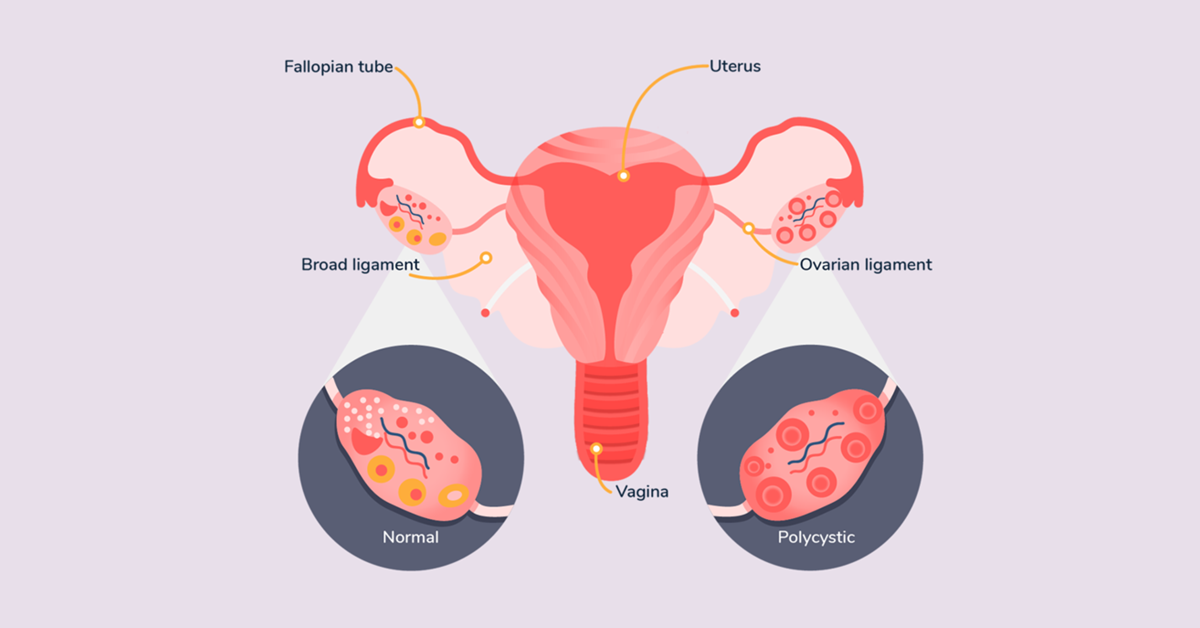What is Polycystic Ovarian Syndrome or PCOS?

Hairy? Acne? Irregular periods? You might have PCOS.
PCOS is one of the most common and misunderstood health problems for women. It’s a hormonal imbalance involving the androgens, insulin, and progesterone. In PCOS, many small, fluid-filled sacs grow inside the ovaries. The word “polycystic” means “many cysts.” These sacs are follicles, each one containing an immature egg. The eggs never mature enough to trigger ovulation.
Causes of polycystic ovarian syndrome
The exact cause of PCOS isn’t known, but researchers suspect that it may be a combination of genes and environment. Also, it might be different causes for different people. Factors that might play a role include:
– Excess insulin: Insulin is the hormone produced in the pancreas that allows cells to use sugar, your body’s primary energy supply. If your cells become resistant to the action of insulin, then your blood sugar levels can rise and your body might produce more insulin. Excess insulin might increase androgen production, causing difficulty with ovulation.
– Low-grade inflammation: This term is used to describe white blood cells’ production of substances to fight infection. Research has shown that women with PCOS have a type of low-grade inflammation that stimulates polycystic ovaries to produce androgens, which can lead to heart and blood vessel problems.
– Heredity: Research suggests that certain genes might be linked to PCOS. PCOS may also run in families. It’s common for sisters or a mother and daughter to have PCOS.
– Excess androgen: The ovaries produce abnormally high levels of androgen, resulting in hirsutism and acne.
Symptoms of polycystic ovarian syndrome (PCOS)
PCOS symptoms are similar to other health conditions, so women are often undiagnosed with PCOS. The most common PCOS symptoms are:–
Irregular periods: A lack of ovulation prevents the uterine lining from shedding every month. Some women with PCOS get fewer than eight periods a year.
– Heavy bleeding: The uterine lining builds up for a longer period, so the periods you do get can be heavier than normal.
– Hair growth: More than 70% of women with this condition grow hair on their face and body — including on their back, belly, and chest. Excess hair growth is called hirsutism.
– Acne: Male hormones can make the skin oilier than usual and cause breakouts in areas like the face, chest, and upper back.
– Weight gain: Up to 80% of women with PCOS are overweight or obese.
– Male-pattern baldness: Hair on the scalp gets thinner and falls out.
– Darkening of the skin: Dark patches of skin can form in body creases like those on the neck, in the groin, and under the breasts.
– Headaches: Hormone changes can trigger headaches in some women.
– Fatigue: Many people with PCOS report increased fatigue and low energy. Related issues such as poor sleep may contribute to the feeling of fatigue.
– Infertility: PCOS is a leading cause of female infertility. However, not every woman with PCOS is the same. Although some people may need the assistance of fertility treatments, others can conceive naturally.
– Mood changes: Having PCOS can increase the likelihood of mood swings, depression, and anxiety.
– Sleep problems: People with PCOS often report problems such as insomnia or poor sleep. Many factors can affect sleep, but PCOS has been linked to a sleep disorder called sleep apnea. With sleep apnea, a person will stop breathing for short periods during sleep.
Complications
– Complications of PCOS can include:
– Infertility
– Gestational diabetes or pregnancy-induced high blood pressure
– Miscarriage or premature birth
– Nonalcoholic steatohepatitis — a severe liver inflammation caused by fat accumulation in the liver
– Metabolic syndrome — a cluster of conditions including high blood pressure, high blood sugar, and abnormal cholesterol or triglyceride levels that significantly increase your risk of cardiovascular disease
– Type 2 diabetes or prediabetes
– Sleep apnea
– Depression, anxiety, and eating disorders
– Abnormal uterine bleeding
– Cancer of the uterine lining (endometrial cancer)
Polycystic ovarian syndrome Diagnosis
- No single test can diagnose PCOS. Your doctor will start by asking about your symptoms and medical history and by doing a physical exam, and possibly a pelvic exam.
- They might give you blood tests to measure your hormone levels, blood sugar, and cholesterol. An ultrasound can check your ovaries for cysts, look for tumors, and measure the lining of your uterus.
Polycystic ovarian syndrome Treatment
Lifestyle interventions are the first treatments doctors recommend for PCOS, and they often work well. Weight loss can treat PCOS symptoms and improve the odds of getting pregnant. Diet and aerobic exercise are two effective ways to lose weight. Medicines are an option if lifestyle changes don’t work. Birth control pills and metformin can both restore more normal menstrual cycles and relieve PCOS symptoms.
Contact Gynaecologists at Regency Hospital to get a check-up done.

 Call-an-Ambulance
Call-an-Ambulance



